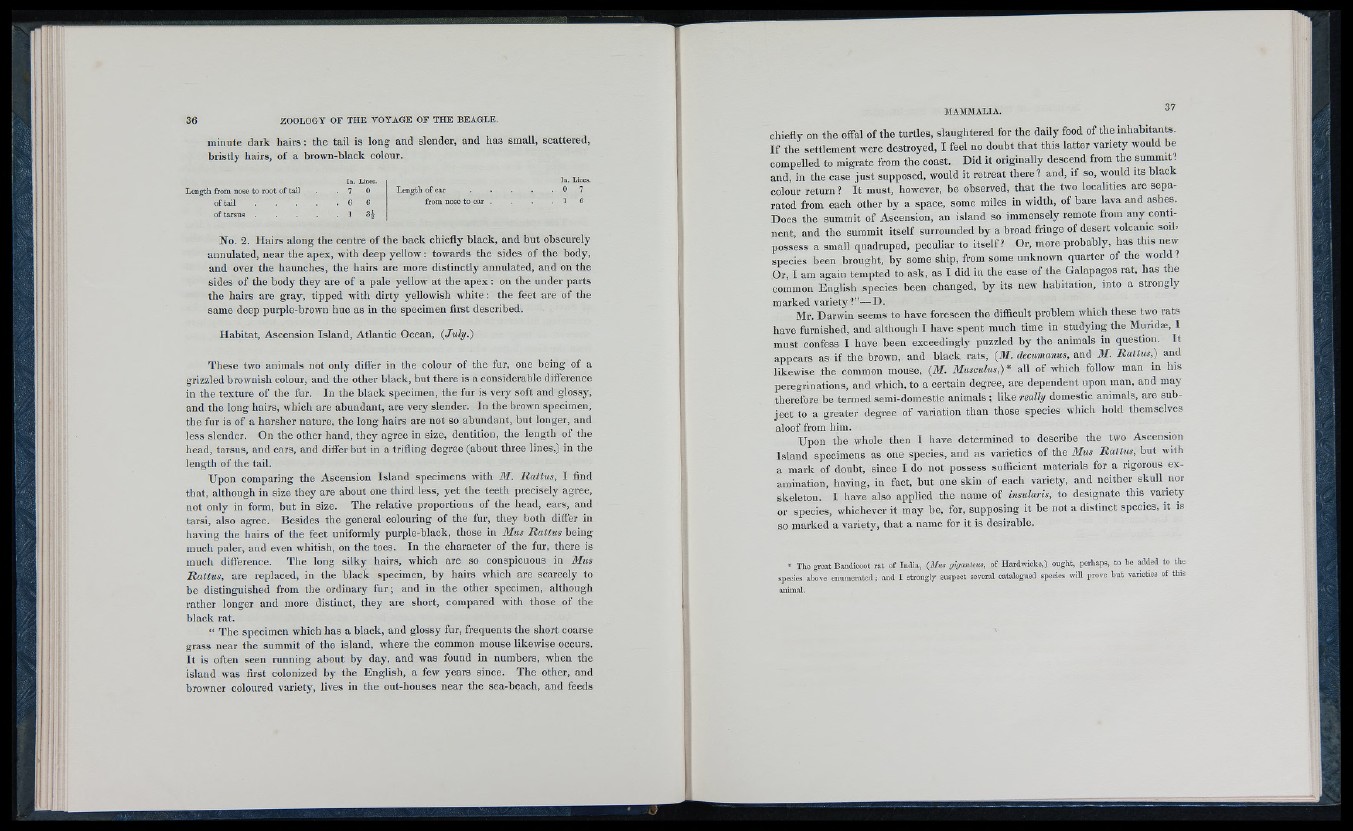
minute dark hairs: the tail is long and slender, and has small, scattered,
bristly hairs, of a brown-black colour.
Length from nose to root of tail
of tail
of tarsns .
In. Lines.
7 0 Length of ear
from nose to ear
In. Lines
0 7
No. 2. Hairs along the centre of the back chiefly black, and but obscurely
annulated, near the apex, with deep yellow : towards the sides of the body,
and over the haunches, the hairs are more distinctly annulated, and on the
sides of the body they are of a pale yellow at the apex : on the under parts
the hairs are gray, tipped with dirty yellowish white : the feet are of the
same deep purple-brown hue as in the specimen first described.
Habitat, Ascension Island, Atlantic Ocean, (July.)
These two animals not only differ in the colour of the fur, one being of a
grizzled brownish colour, and the other black, hut there is a considerable difference
in the texture of the fur. In the black specimen, the fur is very soft and glossy,
and the long hairs, which are abundant, are very slender. In the brown specimen,
the fur is of a harsher nature, the long hairs are not so abundant, hut longer, and
less slender. On the other hand, they agree in size, dentition, the length of tlie
head, tarsus, and ears, and differ but in a trifling degree (about three lines,) in the
length of the tail.
Upon comparing the Ascension Island specimens with 31. Rattus, I find
that, although in size they are about one third less, yet the teeth precisely agree,
not only in form, hut in size. The relative proportions of the head, ears, and
tarsi, also agree. Besides the general colouring of the fur, tliey both differ in
having the liairs of the feet uniformly purple-black, those in 3Ius Rattus being
mucli paler, and even whitish, on the toes. In the character of the fur, there is
much difference. The long silky hairs, which are so conspicuous in jifiis
Rattus, are replaced, in the black specimen, by hairs which are scarcely to
he distinguished from the ordinary fur; and in the other specimen, although
rather longer and more distinct, they are short, compared with those of the
black rat.
“ The specimen which has a black, and glossy fur, frequents the short coarse
grass near the summit of the island, where the common mouse likewise occurs.
It is often seen running abont by day, and was found in numbers, when the
island was first colonized by the English, a few years since. The other, and
browner coloured variety, lives in the out-houses near the sea-heach, and feeds
chiefly on the offal of the turtles, slaughtered for the daily food of the inhabitants.
If the settlement were destroyed, I feel no doubt that this latter variety would he
compelled to migrate from the coast. Did it originally descend from the summit?
and, in the case just supposed, would it retreat there? and, if so, would its black
colour return? It must, however, be observed, that the two localities are separated
from each other by a space, some miles in width, of bare lava and ashes.
Does the summit of Ascension, an island so immensely remote from any continent,
and tlie summit itself surrounded by a broad fringe of desert volcanic soil,
possess a small quadruped, peculiar to itself? Or, more probably, lias this new
species been brought, by some ship, from some unknown quarter of the world ?
Or, I am again tempted to ask, as I did in the case of the Galapagos rat, has the
common English species been changed, by its new habitation, into a strongly
marked variety?”— D.
Mr. Darwin seems to have foreseen the difficult problem which these two rats
have furnished, and although I have spent much time in studying the Muridm, I
must confess I have been exceedingly puzzled by the animals in question. It
appears as if the brown, and black rats, (31. decumanus, and 31. Rattus,) and
likewise the common mouse, (31. Musculus,)* all of which follow man in his
peregrinations, and which, to a certain degree, are dependent upon man, and may
therefore be termed semi-domestic animals ; like really domestic animals, are subject
to a greater degree of variation than those species which hold themselves
aloof from him.
Upon the whole then I have determined to describe the two Ascension
Island specimens as one species, and as varieties of the 3Ius Rattus, hut with
a mark of doubt, since I do not possess sufficient materials for a rigorous examination,
having, in fact, hut one skin of each variety, and neither skull nor
skeleton. I have also applied the name of insularis, to designate tins variety
or species, whichever it may he, for, supposing it he not a distinct species, it is
so marked a variety, that a name for it is desirable.
• Tho gioat Bandicoot rat of India, (M m gigan um , ot Hardwicko,) onght, pcihaps, to bo added to tho
species above enum erated; and I strongly suspect several catalogued species will prove but varieties of this
animal.